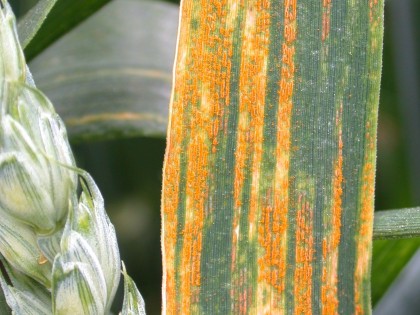
The European Union project RustWatch ran from 2017 to 2022 and involved 24 partner organisations. Niab led one of the five work packages, joining organisations from 12 European countries plus Pakistan, thus consolidating the cereal rust research community and relevant stakeholders across Europe.
The main aim of the project was to seek solutions to challenges posed by wheat yellow (stripe), brown (leaf), and black (stem) rust diseases. Niab is still supporting Europe-wide wheat rust surveillance as part of a new EU research programme IPMorama, data from which will feed into the UKCPVS and vice versa.
The cereal rust landscape within Europe is constantly changing and it is essential for Niab to maintain close links with the European cereal rusts research community. In 2016 Europe experienced the most severe epidemics of wheat stem rust for more than 50 years. In 2017 unusual and severe epidemics of yellow rust were observed on several continents, with the pre-existing populations of wheat yellow rust in Europe having been replaced by invasive races of non-European origin on more than one occasion.
Outputs
RustWatch explored the drivers shaping the European wheat rust populations, and assessed their impact on agricultural productivity in the context of IPM Directive 2009/128/EC.
Outputs included:
- A European wheat rust network including all stakeholders
- Shared facilities and procedures for early-warning and risk assessment
- A better understanding of drivers for spread and establishment of new races
- New IPM-based strategies for disease prevention and control
- Input to EU plant health policy for non-regulated invasive pathogens
The project was coordinated by Prof Mogens S. Hovmøller of Aarhus University (AU), Department of Agroecology, who also is head of the Global Rust Reference Center hosted by AU.
Download NIAB's 2019 event posters summarising the RustWatch project - NIAB Poster 1 and NIAB Poster 2
Papers with Niab staff as co-authors
- Jørgensen, L.N., Matzen, N., Leitzke, R., Thomas, J.E., O’Driscoll, A., Klocke, B., Maumene, C., Lindell, I., Wahlquist, K., Zemeca, L. and Apesteguia, M.B., 2024. Management of Rust in Wheat Using IPM Principles and Alternative Products. Agriculture, 14(6), p.821.
- Zelba, O., Wilderspin, S., Hubbard, A., Nellist, C.F., Mortensen, A.K., Schulz, P., Huerta-Espino, J., Singh, R. and Sørensen, C.K., 2024. The adult plant resistance (APR) genes Yr 18, Yr 29 and Yr 46 in spring wheat showed significant effect against important yellow rust races under North-West European field conditions. Euphytica, 220(7), p.107.
- Rodriguez-Algaba, J., Hovmøller, M.S., Schulz, P., Hansen, J.G., Lezáun, J.A., Joaquim, J., Randazzo, B., Czembor, P., Zemeca, L., Slikova, S. and Hanzalová, A., 2022. Stem rust on barberry species in Europe: Host specificities and genetic diversity. Frontiers in Genetics, 13, p.988031.
Rustwatch videos produced by Niab:
Winter wheat variety trials and RustWatch
Keep up to date with changes in the race structure and genetic groups of yellow rust populations across Europe, Africa, Asia and South America: Yellow Rust Toolbox-Maps and Charts

